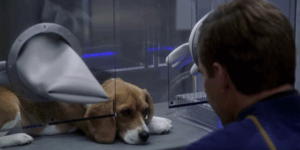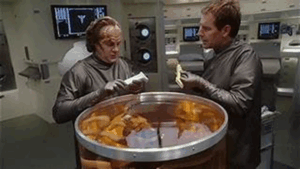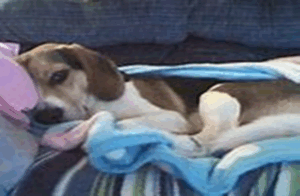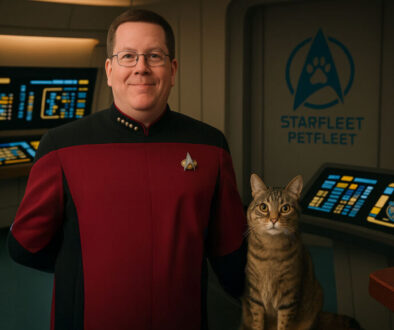Liaison Article
Will Porthos Get Well?
A Fan-Fiction Story, by Captain Deborah Keyes – Region 02 Liaison
Footsteps could be heard running down the corridor to sick bay. As the doors of sick bay slid open, Phlox turned to see Captain Archer holding Porthos. A single tear glittered in Archer’s left eye.
“Something is wrong with Porthos. You’ve got to help him, Phlox.”
“Tell me what’s going on and I’ll see what I can do.”
“ For the last three days, Porthos has been lethargic, has been stumbling, has had a change in his gait, has had trouble breathing, has had loss of appetite, has had depression, has been vomiting, has lost interest in things, hasn’t been himself, has been disoriented, has been confused, and has had a change in sleep patterns.”

“Wow, there’s a lot going on with Porthos. Captain, please lay him down on the biobed so I can examine him and perform some tests. I will get back to you when I figure out what is going on with Porthos.”
First, Phlox checked the biofunction monitor at the head of the bed which gave continual updates of vital signs, pulse and respiration. Porthos’ temperature was 104.2° F, pulse is 62 beats per minute, and respiratory rate is 12 breaths per minute. If I remember correctly a dog’s temperature should be 100-102.5° F, pulse should be 70-140 beats per minute, and respiratory rate should be 15-30 breaths per minute. Porthos’ vitals are all out of the correct range. Next, phlox used the blood analyzer and found three areas where there was concern: tested Pathos’ CBC (hydration status, anemia, infection, blood clotting ability), HCT/PCV (measures percentage of red blood cells), and WBD (white blood cell count, measures the body’s immune and fighting infectioncells). These three areas were well below normal. Phlox decided to focus on various possible diagnosis based on the symptoms.
First, pneumonia. Pneumonia is inflammation in the air sacs of the lungs causing swelling, pus, and yellow, green or bloody mucus, making it hard for Porthos to breath. Infection and a fever over 102.5° F were commonplace.

Phlox checked Porthos’ gums, nasal passages, inside of the eyes, and genitals for discoloration. If discoloration is seen there isn’t enough oxygen passing through Porthos’ system. Because of this lack of oxygen, the dog is often listless, exhausted and doesn’t eat much. Pneumonia could be a possibility. However, once Phlox gave Porthos some antibiotics his breathing improved and his oxygen level increased. Phlox then decided to rule out pneumonia.
Next, common signs of kidney failure in dogs include depression, lack of appetite, lethargy, diarrhea, constipation, vomiting and weight loss. Other symptoms include increased thirst, increased volume and increased frequency of urination. Blood in the urine, blindness, seizures and coma may also occur. Kidney failure results are found in urine and blood tests. Phlox, after he performed urine and blood tests on Porthos, was able to rule out kidney failure.
“Is it possible that Porthos could be experiencing Dog dementia? This is when the brain’s inability to function properly due to age.”
Formally known as Canine Cognitive Dysfunction Syndrome (CCD or CDS) or
dog Alzheimer’s, CDS occurred when there were changes to the brain, including abnormal protein accumulation, plaque, in the brain’s frontal lobe and degeneration of brain cells.
The frontal lobe controls things like memory and learning. Once the plaque spreads to other parts of the dog’s brain, it can affect spatial awareness, among other functions.

First, Phlox put Porthos in an imaging chamber used for full body scans. The biofunction monitors displayed the progress of treatment. Phlox decided to use a neural interface which allowed a direct connection to be formed between the computer system and Porthos brain. Using a neural oscillator, he tried to stabilize Porthos’s brain waves. There was a slight improvement, so he used a neurocortical probe to stimulate the growth of synapses in his brain by manipulating neural proteins at the subatomic level. He also used a myelin regenerator to regenerate the myelin sheath of a nerve, and he used a memory extractor to scan and repair neural impulses.
Lastly, Phlox focused on Porotho’s stumbling, balance loss- falling to one side, clumsiness, head tilting, and uncoordinated or change in gait. These symptoms are an indication that the brain isn’t communicating properly with the body, such as the ear, brain, or spine. This is known as ataxia. In the past, there has been no cure for ataxia, but the symptoms can be managed with medication: anti-inflammatories, anti-biotics, anti-fungal, anti- nausea, antioxidants (to protect brain cells) and pain management. A change in diet, regular exercise and playtime which helps keep dogs physically and mentally fit.
However, Phlox has been experimenting with new potential medication for ataxia and for dementia. He combined anti-inflammatories, anti-biotics, anti-fungal, anti- nausea, antioxidants and pain medication to varying degrees in test tubes. He had started to have some success but was leery to use Porotho’s as a Guinea pig.
“Captain Archer, Phlox here, please come to sick bay.”

As Archer entered sick bay, Phlox noted he was disheveled from apparent lack of sleep.
“Did you figure out what is wrong the Porthos?”
“I believe I have. Porotho seems to have
dog dementia and apaxia, a rare combination. I have been testing various concoctions to try to find a cure. Progress has been slow but promising. I would like to try a few inoculations on Porthos and see how things progress.”
“What is the prognosis?”
“That’s hard to tell. If he doesn’t get the treatments, he is apt to get worse.”
“I trust you Phlox. You’ve never let me down before.”
Phlox filled a hypospray with his first inoculation and injected Porothos. Phlox monitored Porothos and after 24 hours injected him a second time. Phlox noticed that Porothos appeared to be getting better. He decided to give him one more inoculation and then tested him and saw noticeable progress. He called Archer to sick bay and gave him the encouraging news.
“Phlox, how can I ever thank you?”
“ Some Denobulan Loatac Cider would be nice.”
Written by Captain Keyes
Petfleet liaison for Region 2
References used:
- https://petdt.com/dog-wont-eat-or-drink-and-just-lays-there/
- https://www.startrek.com/news/porthos-bio
- www.thesprucepets.com/pneumonia-in-dogs-4692197
- https://www.thesprucepets.com/ataxia-in-dogs-4686102
- https://memory-alpha.fandom.com/wiki/Porthos
- https://www.bing.com/search?q=dog+diseases+and+symptoms&gs_lcrp=EgRlZGdlKgcIBBBFGMIDMgcIABBFGMIDMgcIARBFGMIDMgcIAhBFGMIDMgcIAxBFGMIDMgcIBBBFGMIDMgcIBRBFGMIDMgcIBhBFGMIDMgcIBxBFGMID0gEKODcwNjcwajBqNKgCCLACAQ&FORM=ANAB01&PC=HCTS
- https://www.purina.com/articles/dog/senior-dog/health/dog-dementia?utm_campaign=prp-NB+-+Dog+Dementia+-+Article+-+Broad&utm_medium=cpc&utm_source=bing&utm_content=&utm_term=can%20dogs%20get%20dementia&gclid=3427b188533416d19c2fd99851883cc3&gclsrc=3p.ds&
- https://www.thesprucepets.com/dogs-and-grief-1118470#:~:text=Just%20like%20people,%20all
- https://memory-beta.fandom.com/wiki/Porthos
- https://www.bing.com/search?q=star+trek+Archer%27s+dog+Pathos+is+how+old&cvid=cf3eb7082d1849debc670df6dd8f05d6&gs_lcrp=EgRlZGdlKgYIABBFGDkyBggAEEUYOTIGCAEQABhAMgYIAhAAGEAyBggDEAAYQNIBCTkyMzczajBqNKgCALACAA&FORM=ANAB01&PC=HCTS
- https://alloftheanimals.com/porthos-was-a-particular-breed-of-beagle/
- https://www.leelanauveterinarycare.net/understanding-your-pets-blood-test-results/


